Analyzing matchup data is fascinating, but Flesh and Blood is more than just game results. At its heart is a vibrant community of players, each bringing unique attitudes and motivations to the table. Ever since I started playing, I’ve often wondered: What draws these people to FaB? Are they here for the same reasons I am? And how do I convince my girlfriend that spending over €500 on a competitive deck is perfectly normal?
Fueled by these questions, I decided to run a small survey during The Calling: Florence.
After several intense days of nonstop play, my friend Davide Giacca and I mustered our last reserves of energy to ask 36 players to fill out a brief questionnaire on their phones. Thanks to their generosity and enthusiasm, I’m excited to share the results—a snapshot of the Flesh and Blood community, its demographics, preferences, and unique engagement with the game.
Who Plays Flesh and Blood?
The survey highlights a fascinating mix of players, though some patterns stand out. The community skews heavily male, with young adults dominating the scene. Most players fall between their late twenties and early thirties, including a minority of students and a majority of professionals, each balancing their passion for FaB with other life responsibilities.
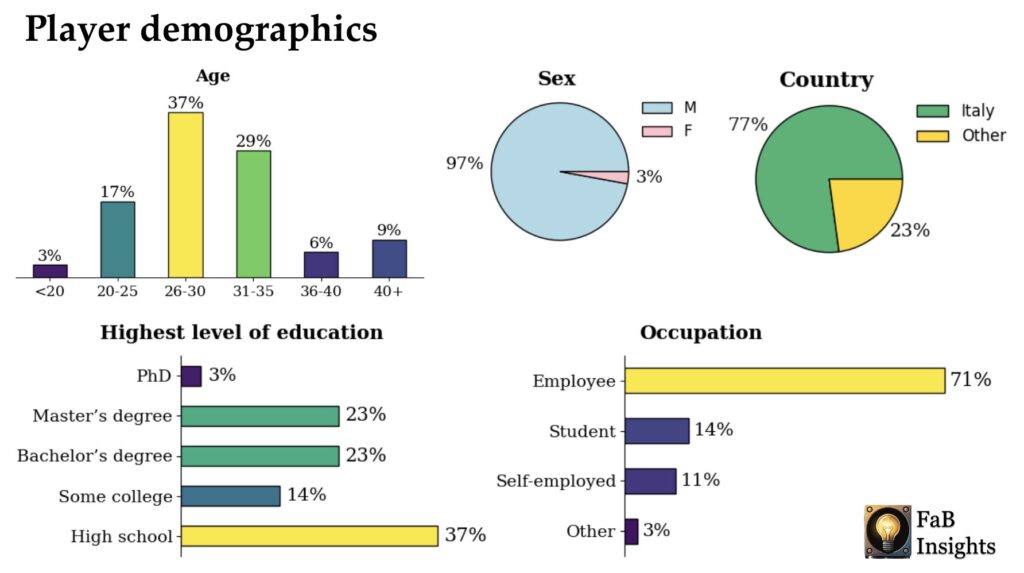
The players also showcase diverse educational backgrounds, with a substantial portion having completed higher education. Many participants are students or professionals, representing fields ranging from content creation to development and teaching. This variety reflects the game’s ability to appeal to a broad spectrum of individuals, from hobbyists to those seeking intense strategic competition.
Italy’s strong representation reflects its role as the host nation, but smaller groups from abroad (in my sample, the Netherlands, Finland, Austria, and Slovenia) demonstrate the game’s growing international appeal.
Finally, we managed to collect a nice distribution of Elos, with several players above the 1600s, up to 1800 points.

A Spectrum of Experience and Commitment
FaB players range from seasoned veterans to fresh recruits. While nearly half of the participants have been playing for over three years, a significant number have joined within the past one to two years, showcasing the game’s ability to attract and retain new players. This balance between experience levels creates a dynamic ecosystem where newer players can learn from veterans while injecting fresh energy into the community.

When it comes to time investment, most players dedicate 5–10 hours a week to FaB-related activities, from deck-building to gameplay. However, a notable portion spends even more time engaging with the game, emphasizing the level of passion within the community.
Competitive Play and Preparation for The Calling
Players were driven by a mix of passion, growth, and connection. Most cited their love for the game and a desire to improve as key motivations, with competition and social bonds also playing a significant role. Interestingly, while prizes were a factor, intrinsic rewards like personal growth and camaraderie were more important.

The majority of participants rated their skill and confidence levels in the mid-range, reflecting a diverse field where seasoned competitors and newer players intersect. This balance highlights the welcoming yet challenging environment that tournaments like the Calling provide, fostering both competition and community.

One thing to note is that people rated their confidence about the Calling as lower compared to their skill level. This might be due to the main event being Sealed/Draft, where chance plays a slightly greater role, while in CC each player has time to prepare on a familiar list.
Experience with other TCGs
While most players have experience with other TCGs, it’s exciting to see that some are entering the TCG world for the first time through Flesh and Blood. Despite their backgrounds in other games, the majority of players report being fully dedicated to FaB. Unsurprisingly, Magic: The Gathering is the most commonly mentioned TCG among players—myself included. Anecdotally, I’ve also heard of many MtG players transitioning to FaB, and this data appears to support that trend.
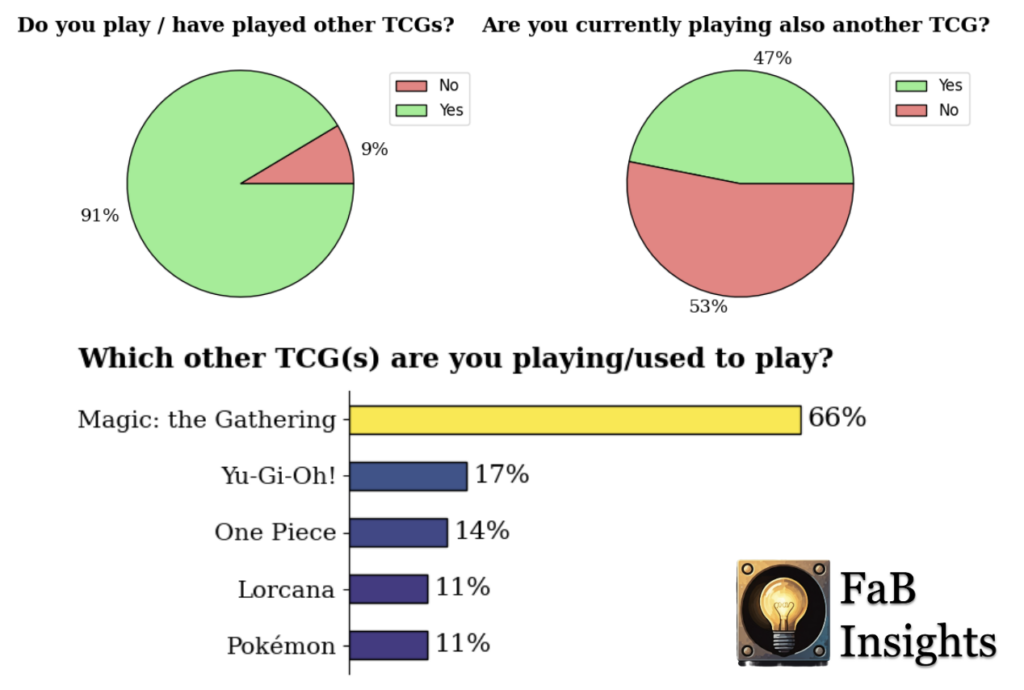
Spending and Price Perception
The financial commitment to FaB varies widely, but it’s clear that many players are willing to invest significantly in it. More than half of the respondents reported spending over €3,000 since starting the game, while others noted more modest budgets. Several have indicated that I needed to put some more choices beyond the “More than 3000 €”. I guess I was anchored to the slightly lower amount I have spent so far, but lesson learned.

When it comes to what they primarily spend their money on, almost all report buying singles. This goes hand in hand with the purchase motivation of building competitive decks rather than collecting or investing – although nearly half reported those motivations as well.

Interestingly, when asked to compare FaB’s pricing to other TCGs, the majority found it reasonable or acceptable, though some suggested room for improvement. A small but vocal group viewed it as excellent value, while others expressed concerns about the cost of entry. The consensus, however, leans toward the notion that while FaB can be an investment, its rewards—both competitive and social—justify the cost for most players.
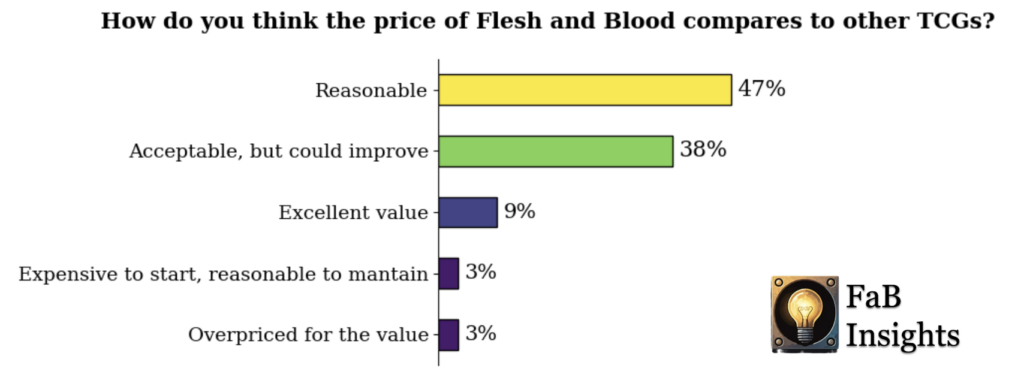
Community Engagement
Perhaps the most striking insight from the survey is the sense of belonging players feel within the FaB community. This sense of connection is reflected in their high ratings of community belonging. Many players reported feeling a strong bond with their fellow enthusiasts, underscoring FaB’s reputation as a welcoming and inclusive environment.
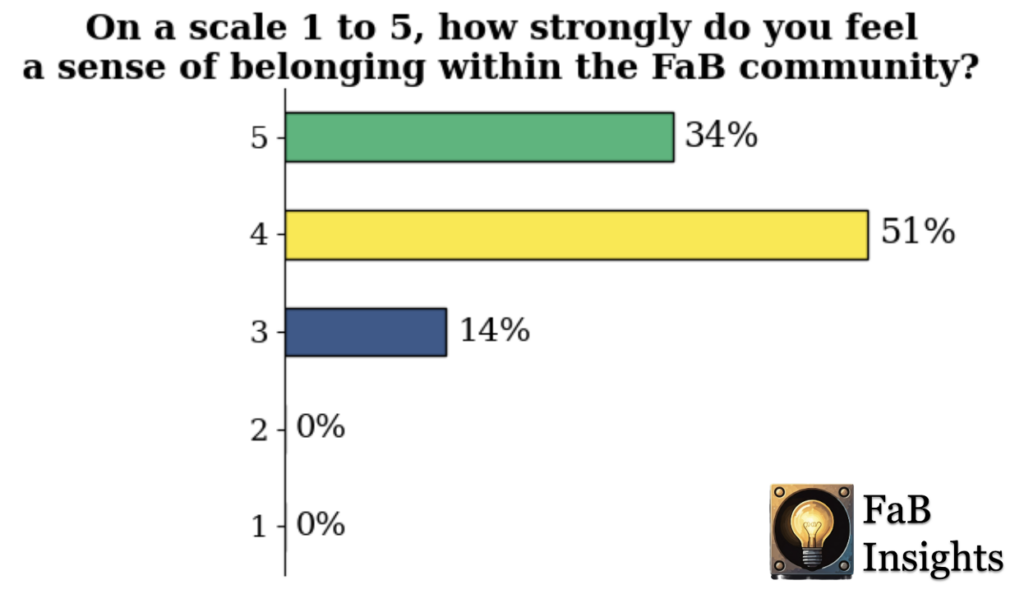
Most participants engage with the community on a weekly basis or even daily basis, whether through local game stores, online forums, trading, or by creating content for fellow players.
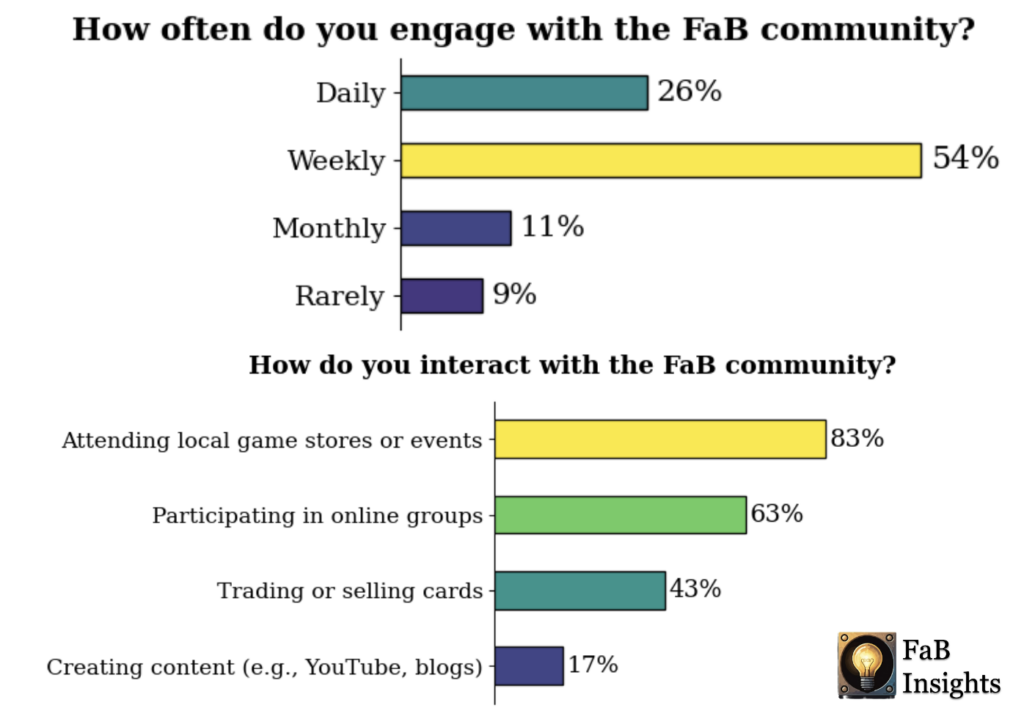
Personality Traits and Player Insights
To gain deeper insights into the community, the Cognitive Scientist part of me decided to include an analysis of the Big Five personality traits: agreeableness, conscientiousness, extraversion, neuroticism, and openness. These traits are commonly used to understand behavioral tendencies and interpersonal dynamics. While my sample of 36 participants was too small to draw significant conclusions on these aspects, a few interesting trends emerged.
Overall, the surveyed players did not differ meaningfully from general population averages across most traits.
Interestingly, extraversion levels vary widely (see length of error bars on the plot below), suggesting that FaB attracts both outgoing players and those who prefer quieter, strategic engagement. There was also a slight trend toward lower neuroticism, pointing to a calm and confident player base, essential traits for navigating the highs and lows of competitive play.
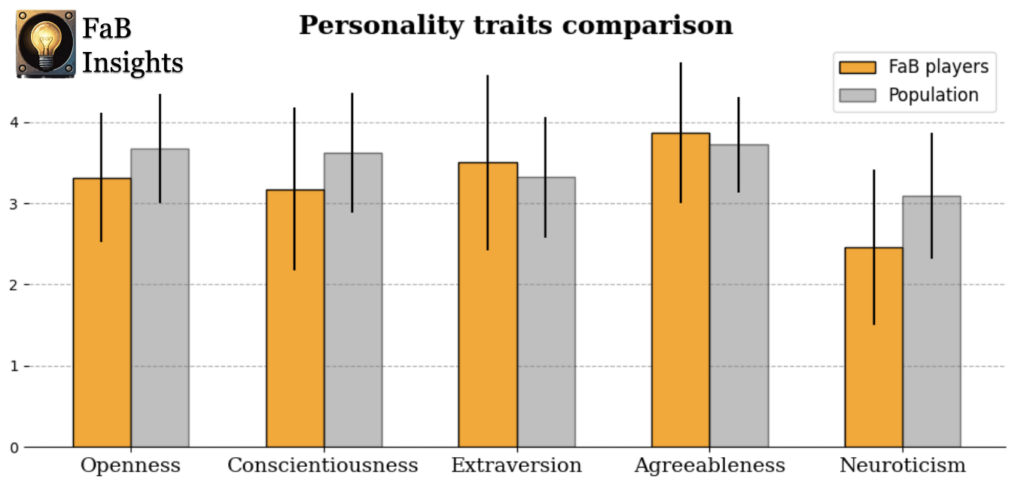
Diving deeper, it emerged that this lower neuroticism trend was driven by players who rated their skill level higher (left plot below). Neuroticism reflects emotional sensitivity and susceptibility to stress, so this finding suggests that players with greater perceived skill may also have higher emotional stability, possibly stemming from confidence and experience in high-pressure environments.

Additionally, players with greater confidence going into the tournament tended to score higher in conscientiousness (right plot above), a trait associated with organization, self-discipline, and reliability. This suggests that players who prepared more thoroughly for the Calling may have felt more optimistic about their performance.
Although these observations align with the demands of competitive play, they remain anecdotal due to the sample size. Future research with a larger dataset could explore these relationships further, providing a clearer picture of how personality traits influence success and engagement in the Flesh and Blood community.
Some final thoughts
When I first envisioned this survey, my plan was to collect responses during the breaks between matches. Being my first Calling—and not exactly the fastest player—I quickly realized that such breaks were almost nonexistent. By the end of day one, after skipping a proper lunch and barely catching my breath, the idea of going around asking people to fill out a questionnaire felt daunting. I think the before/after picture below gives a pretty good sense of how I felt…

Still, I was deeply honored when some opponents recognized me as “the guy who published those cool stats.” It was even more exciting to chat about my work with a few pro players.
Although this survey was a small test, the sample size (more than 20% of participants!) provides solid insights into the community. While I avoided crossing too many variables this time, my hope for the future is to gather a larger sample and explore correlations between survey responses and objective performance metrics, like Elo ratings or tournament results. That would open the door to even more fascinating studies about what drives success in Flesh and Blood.
I’d like to thank the respondents for their time and openness, which reflects the warmth and friendliness of this community. A huge shoutout as well to my friend Davide Giacca—without his support, this project wouldn’t have gathered enough data to be meaningful.
See you all in Prague?



